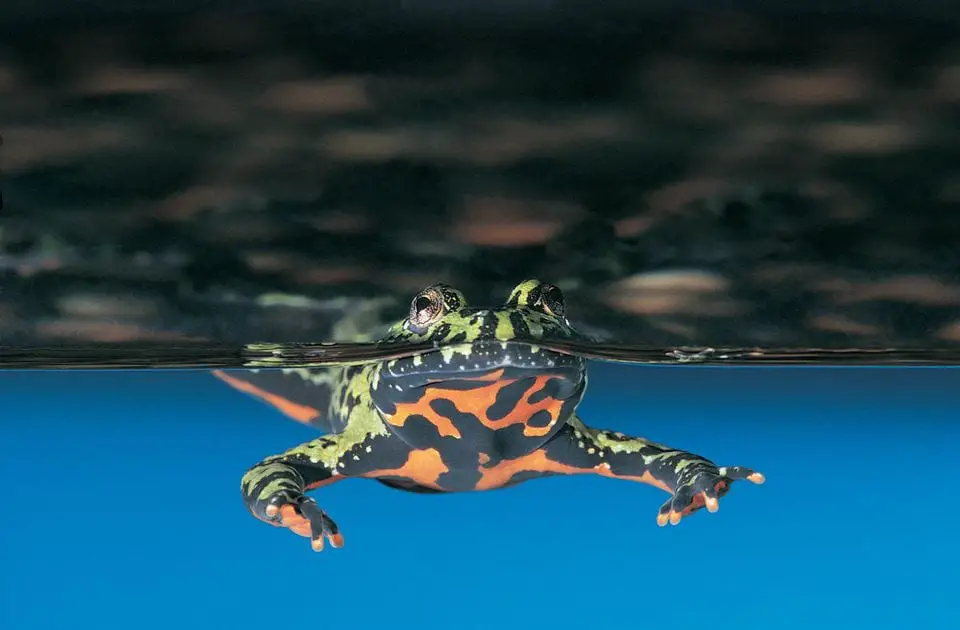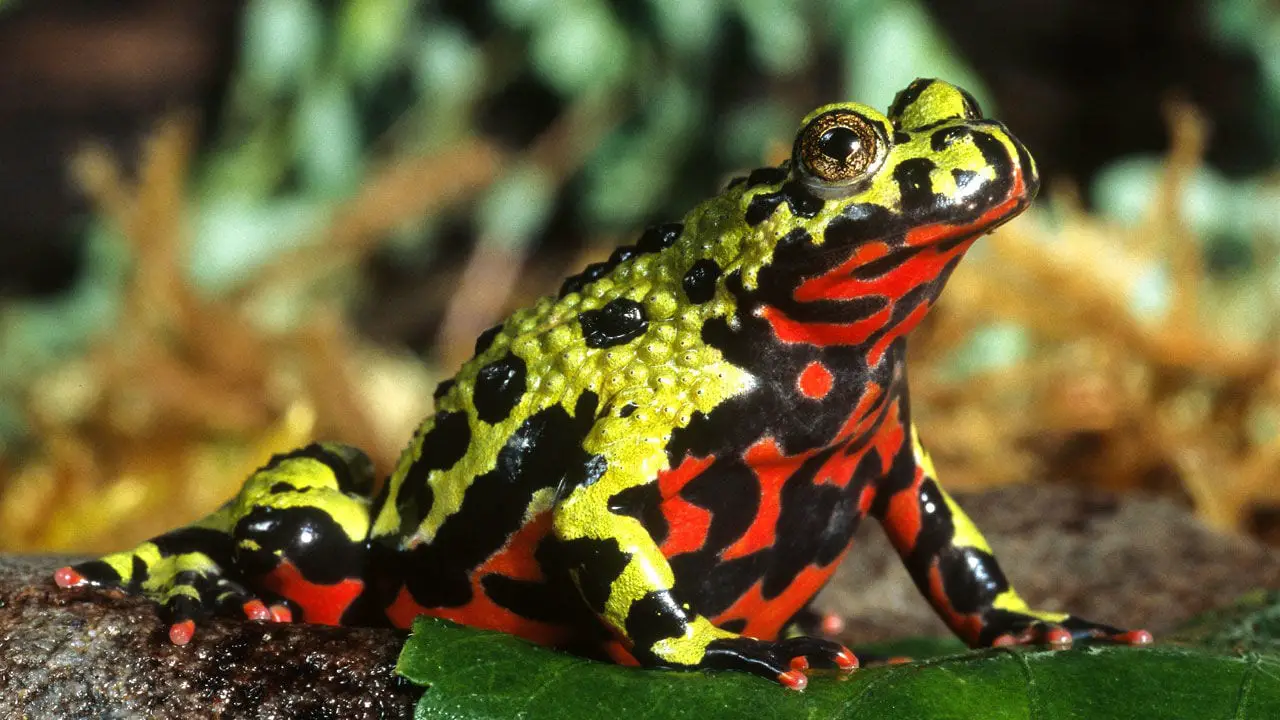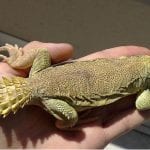Scientific Facts
| Common Name: | Oriental fire-bellied toad |
| Scientific Name: | Bombina orientalis |
| Life Span: | Up to 20 years 9 (in captivity) |
| Size: | 1.5 to 2 inches |
| Habitat: | Streams, ponds, and forests |
| Country of Origin: | Northeastern China, Southern Japan, Korea, and Southern Russia |
Physical Description
The oriental fire-bellied toads are small, semi-aquatic species of frogs found in Korea, Russia, and northeastern China. They can be called frogs, despite their common name. These animals are called toads due to the tubercles on their backs.
These toads are usually bright green and have black mottling on their dorsal areas. However, their complexion can also be dark brown to black that depends on their background. These toads have bright red to yellow ventral area mottled with black to dark brown. The small tubercles cover the skin on their dorsal side.
The oriental fire-bellied toads are noted for their black and bright green pigmentation on their backs and black and orange on their undersides. These colors serve as a precaution to their predators regarding toxicity. Their skin secretes a toxin, mostly from their hind legs and belly, in the milky-like substance if the frog is frightened or disturbed. If disturbed, the oriental fire-bellied toads will release this toxin. Also, they may lie on their backs to show their colorful bellies, which indicate their toxicity to predators.
Habitat and Range
These frogs are among the most popular amphibians in the primary range. They thrive in Korea, Northeastern China, Southern Japan, and Southern parts of Russia. These animals are very aquatic and normally found in the ponds and slow-moving streams.
When they come out of the water, they stay at the broadleaved and coniferous forests. The oriental fire-bellied toads hibernate at the end of September until May. When they hibernate, they will stay in the rotting logs, piles of leaves, and sometimes on the bottom of the streams.
Population
The oriental fire-bellied toads are medium-sized frogs that often reach a length of approximately 2 inches. Their backs that are covered in spiky-looking warts could be brownish-gray to bright green. Their bellies feel smooth.
Tadpoles feast on fungi, plants, and algae. Adults eat invertebrates such as insects, worms, and mollusks. The oriental fire-bellied toads are famous in the commercial pet trade. However, they’re common across their range. They don’t have a conservation status.
Communication

Compared to most toads and frogs, they don’t have tympanic membranes or eardrums. They don’t have resonators. Instead, they make calls using inhalation instead of exhalation. If threatened, the oriental fire-bellied toads make use of a distinguishing defensive posture.
They bend their backs downward as if they form a bowl-shaped surface to show the edges of their bright bellies. They also hold their limbs upward and arch their heads in the posture known as the “Unken Reflex.”
When attacked or provoked, a 2nd defensive stage will occur, in which these frogs flip on their backs to show their coloration. If the predators keep on provoking these frogs, they will secrete a milky-like toxin through those coated tiny pores scattered across their bodies.
Once the predators taste the released toxin, they will rarely attack the frogs again. However, water serpents and grass snakes can still attack and eat these toads without getting poisoned.
Eating Habits
These toads can’t extend their tongues like other frogs or toads. To feed, they should leap forward and catch the prey using their mouths. Larvae consume detritus, fungi, algae, protozoans, and higher plants. Likewise, they tend to consume bigger food items and in larger amounts as they mature, considering the increase in animal and plant diversity.
They start consuming terrestrial invertebrates before the process of metamorphosis is over. The toadlets will still have tiny tails. The foods for adults consist of terrestrial invertebrates, such as mollusks, insects, and worms.
Social Structure
The oriental fire-bellied toads can be extrovert animals. They seem friendly in some ways.
Development
These frogs will hibernate from fall until late spring is small groups consisting of 1-6 individuals. They hide in the heaps of leaves and stones, rotten trees, and underwater in the streams. When higher temperatures occur in mid-May, the oriental fire-bellied toads will emerge and begin breeding.
The males float on the water with their splayed legs and call the females with the sound that is like the sound produced when you tap the musical triangle. It’s like the ting-ting sound, which rarely lasts long for more than 15 seconds.
Mating typically takes place at night. During this period, the males grasp the females in front of their hind limbs. This position is called amplexus. To keep the grip stronger, the males use the bumpy nuptial pads found on their inner thumbs. However, those unresponsive females can also writhe their way out.
The males will usually work themselves in the rage that they may hold on to anything by accident, thinking that it is a toad. It can be the plants, floating twigs, newts, human fingers, fish, and other toads or frogs.
The reproductive time is so extensive in every population since females lay their eggs at different times. Breeding pairs can be randomly formed. When a pair successfully mates, the female may deposit 40-110 eggs individually or in the tiny clumps of around 4-25 eggs near the water surface, in which the warmness of the sun can support the development of an embryo.
After around 6-8 weeks, the hind limbs will start to appear, and one of them will develop from the spiracle. It signifies that the lungs of the developing embryo start to develop.
Tadpoles will often go up and appear on the water’s surface to breathe. In the 8 to 14 weeks, these developing tadpoles will go through the critical stage in which they start to metamorphose and grow into mature amphibians. Tadpoles will finish metamorphosis in the 4th week of either August or September.
Lifespan
The oriental fire-bellied toads are among those frogs with longer lifespans. Many of them live for 12-15 years. When they grow in captivity, they may live for up to 20 years.
Reproduction
Breeding in oriental fire-bellied toads occurs in the spring as the weather is a mix of hot, sunny, and rainy days. The males call the females with the light barking croak. They jump on the back of other fire-bellied toads, which occurs to pass over, which typically leads to accidental male-to-male breeding.
Mated females will lay 40-100 eggs in the big cluster, commonly around the submerged plants beside the edge of the water. Tadpoles start to develop their legs in 6 to 8 weeks. They are completely metamorphosed in this period. They start to come out of the water and explore the land on the 12th to 14th weeks of their lives.
Predation
The major predators of oriental fire-bellied toads are the big aquatic animals and birds. They are venomous to eat. When scared, they show their bellies and arch their backs. Predators may stop chasing them once they see the toxic coloration on the bellies of these toads. Also, these frogs are capable of hiding and blending into the environment to prevent other animals the water snakes that are immune to their poisonous secretion.
Ecosystem Roles
The oriental fire-bellied toads attack the terrestrial invertebrates, larger water animals, and birds.

Their Positive and Negative Effects on Humans
Though they are venomous, these toads are great pets. The deadly toxin on their skin is not harmful to a person’s skin but can harm when rubbed into the mouth, eyes, and broken skin. Hands must be washed carefully before and especially after handling. Handling these frogs may cause a runny nose and itchy eyes.
In Captivity
In Europe and the United States, these frogs are typically kept as pets. They are hardy, so they grow well even in captivity, provided that adequate food and clean water are available. Those toads raised in captivity can eat tiny crickets covered with calcium powder.
They can be fed as well with some other tiny invertebrates like earthworms. The larvae of mealworms have headshells which the oriental fire-bellied toads may find difficult to digest and pass. While they are not the most harmful of all amphibians, still these frogs are not ideal for regular handling.
Though their venom is dangerous to their skin when ingested, the mucus may cause discomfort. Due to their mild poisonousness, the oriental fire-bellied toads tend to be incompatible with other kinds of amphibians.
In captivity, these animals can last for decades. Many of them lasted for 15 years. According to older reports, they can live for up to 30 years. When raised in captivity, give them anything rich in beta-carotene like carrots to prey insects or crickets earlier in the adult phase. This will allow them to develop a brighter coloration.
The oriental fire-bellied toads must be kept in water with some type of island or land to let them go out of the water for some time. These frogs aren’t good swimmers and may drown in deeper water.
The best enclosure for the oriental fire-bellied toads is the one with more water-based and land-based hiding areas, including the land-based location ideal for depositing live foods. These fire-bellied toads can be sensitive to chloramine and chlorine.
Tap water must undergo treatment and be permitted to stand for days, allowing the chlorine to dissolve before using it for your pets. Chloramine must not dissolve in this way, so tap water that has been treated using chloramine should be treated as well by using a specific dichloramine agent. Make sure you let it stand before adding to the treated water.
Temperament and Behavior
The bright coloration of these frogs helps them ward off the predators. While their venom is not the most harmful of all venomous frogs, regular handling of oriental fire-bellied toads is not suggested. You must avoid them all, especially if you have wounds on your hands. Don’t forget to wash your hands carefully after touching the toads and cleaning their enclosures.
Because of their possible toxicity, avoid putting these toads together with other frogs in just one enclosure. Replacing the water and regular cleaning will help in keeping the harmful toxins from accumulating inside the enclosure.
The oriental fire-bellied toads don’t have extending tongues, so they are using their mouths in grabbing food items and other things using their forelegs. These clever toads will often tell its toxicity to predators by just revealing their bellies. Predators will eventually realize their bright coloration would make them sick if they eat these toads.
Housing
A 10-gallon tank is an ideal enclosure for one oriental fire-bellied toad. However, any enclosure of this size can house 2 to 3 frogs. A big number of frogs may live happily in a bigger tank that can offer around 4 gallons of space for each frog.
The long style enclosures can give these frogs a bigger floor space. Moreover, the enclosure must have a safety lid considering how active these small frogs are. They may escape if you give them a chance to do so. The top part of the enclosure must enable adequate ventilation.
Semi-aquatic tanks are also best to use for oriental fire-bellied toads. With 1/3 to ½ of the enclosure, a dedicated land area, and the rest as the water around 2-4 inches deep. The land area can have rocks that must be smooth to avoid injury to sensitive frog skin, plants, damp moss, and certain spots to hide.
The water must have frequent, and filter water replacements are important. Use dechlorinated old water or spring water inside the enclosure. These toads produce some waste, so persistent partial water replacements must be done. Smooth gravel could be used in lining the waterside, artificial, or live plants could be used.
A heater isn’t typically required as these toads can handle and survive from room temperature, though warmer and higher temperatures are mostly better. Try to set the temperature between 75 to 78 degrees Fahrenheit. The basking spot could be set up with low-wattage lamps, use your thermometer, and aim for the temperature of around 78 degrees Fahrenheit.
Lighting
Tiny incandescent light bulbs can be an effective source of heat when necessary. Fluorescent lights are not necessary, but they would make the enclosure more beautiful and will let you cultivate live plants inside if desired. Aim for the photoperiod between 10 and 12 hours.
Temperature
The oriental fire-bellied toads can tolerate various temperatures, which is among the reasons why they do well when raised in captivity. Daytime temperatures may range from 65 to 78 degrees Fahrenheit or 18 to 26 degrees Celsius. Remember to reduce the temperature at night. Prevent the temperature from more than 82 degrees Fahrenheit or 28 degrees Celsius.
Substrate
A substrate crafted using cocoa husk, compost or sandy topmost soil, live moss, peat, sphagnum moss, and a range of live plants can help boost the humidity within the enclosure. Do not use gravel, as your toads may become impacted when they accidentally ingest it.
Humidity
The oriental fire-bellied toads require high humidity levels, but they also need sufficient ventilation. In keeping the humidity at the ideal level, consider adding a big water bowl and doing regular misting the cage with de-chlorinated water poured in the spray bottle. A hydrometer may also help in checking the humidity levels within the enclosure.
Water and Food
These toads may take various prey items, ranging from crickets to worms like earthworms and waxworms. However, mealworms may not be good for oriental fire-bellied toads because of their hard exoskeleton. The same is the case for certain tiny feeder fish like guppies.
Prey must be dusted with the multivitamin powder and gut-loaded at the same time. The certain tiny feeder fish like guppies usually have a good appetite and feeding response. Captive-bred and raised species typically do well in terms of feeding. Typically, adults should be fed twice or thrice a week.
Always remember to feed your pets properly. Don’t introduce more than what they need to prevent obesity.
Cleaning
Also, do a routine inspection of the terrarium of your pets. Spot cleaning must be done daily when you replace the water in the bowl. Likewise, you need to clean out the enclosure thoroughly and sterilize it by using an amphibian/reptile friendly disinfectant. Sterilize the decorations and remove carefully the live plants once you clean the enclosure. The water enclosure’s waterside should be emptied, refreshed, and cleaned with fresh and clean de-chlorinated water. Take your pets out of the enclosure and put them on a temporary cage while you’re cleaning the enclosure.
Handling
The toxin excreted through the skin of the oriental fire-bellied toads can be irritating to human skin. This is the reason why regular handling is unideal for these frogs, but this could be inevitable.
If you need to hold your toads, then you should use a pair of protective gloves that will protect you and even your pets as their skin is delicate to different chemicals that might be lingering on your hands like soap residue, wash-up liquid, and hand cream. In cleaning the enclosure, you can remove the toads and transfer them to a vacant tank by using the aquarium net intended for fish.
Availability – Where to Get One?
The oriental fire-bellied toads are among the most traded amphibians, so finding them should not be difficult. You may look for thee amphibians in the pet stores, even those stores that are not specializing in amphibians or reptiles.
Since these frogs are originating mostly from the forests, contacting the local herpetological community and searching for people who have been breeding oriental fire-bellied toads may help.
Choosing the Best Oriental Fire-Bellied Toads
These frogs are small and easy to keep. Therefore, they can be an excellent choice of pet, even for novices. The best way to buy them is from a reliable amphibian breeder who knows the history of oriental fire-bellied toads and the possible health issues they may incur. Healthy oriental fire-bellied toads have clear eyes and smooth skin, though these animals have rough and bumpy skin.
Common Health Issues Among Oriental Fire-Bellied Toads
Redleg disease is a typical health problem among these toads in captivity. This disease is caused by the parasitic infection, and toads or frogs are having this health condition develop reddened legs, which is the initial symptom. If you suspect your pet is having this health issue, then bring it as soon as possible to a veterinary clinic that specializes in reptiles. Those toads that are experiencing this condition would be sluggish and indifferent. A veterinarian can easily confirm and treat it, though.
Like other frogs, the oriental fire-bellied toads are also prone to fungal infections. If your pets seem to have inflammation on their faces and ooze a cotton-like substance on their skin, then you must bring them to a vet right away. This condition is manageable if detected earlier.
How to Care for Oriental Fire-Bellied Toads?
Taking care of these frogs is quite easy and less tedious. The toads will be okay as long as you provide them a bigger enclosure, stable food supply, a good substrate, enclosure decorations, clean water, and so on. Proper husbandry plays a big role in extending the lifespan of these animals.
FAQs
Are oriental fire-bellied toads friendly?
These toads are friendly as they feel okay even if you put them together with other animals inside the enclosure. You can also keep them as a group of up to 6 individuals in one enclosure.
Do oriental fire-bellied toads cause harm to people?
The oriental fire-bellied toads are poisonous and can’t be handled regularly. Wear your gloves to protect yourself against the milky-like poison excreted through their skin.
How big do oriental fire-bellied toads grow?
The oriental fire-bellied toads are among the smallest frogs living on earth. These species measure 1.5 to 2 inches.
What is the scientific name of oriental fire-bellied toad?
This frog is a semi-aquatic species. Its scientific name is Bombina Orientalis.
How do oriental fire-bellied toads release their venom?
The oriental fire-bellied toads don’t have sharp fangs that release venom. Instead, they excrete this toxic substance through their skin, which may cause irritated eyes and mouth to other animals and even humans.



